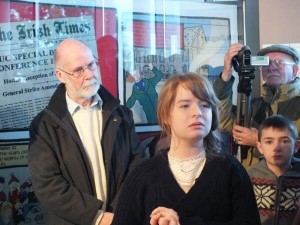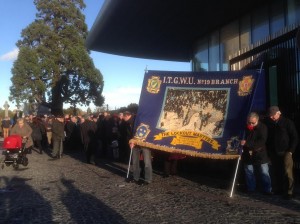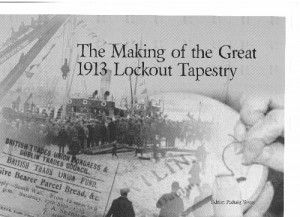ANU Nominated for Two Irish Times Theatre Awards acknowledging its Dublin Lockout Productions

Caitriona Ennis as Alicia Brady at Commemoration in Glasnevin Cemetery Museum on January 4th, 2014 with Panel of Shooting top right


Caitriona Ennis as Alicia Brady at Commemoration in Glasnevin Cemetery Museum on January 4th, 2014 with Panel of Shooting top right
Saturday, January 25th:

2:30pm: After Lockout Centenary – Trade Union Organising in 2014 and Beyond. Dun Laoghaire Club, Eblana Avenue, Dun Laoghaire
Speakers include Gerry Craughwell, President Teachers Union of Ireland,
Eira Gallagher (SIPTU), Jimmy Kelly (Unite).
Workshops: Facing the challenges in workplaces and communities – practical steps in how to organise
Panel Discussion – Into the Future with Padraig O Tomhair (Independent Workers Union), Ethel Buckley (SIPTU) and Migrants Rights Centre representative
Concluding remarks: John Douglas (President Irish Congress of Trade Unions)
For Full Programme go to Events Page
‘Labor & Dignity – James Connolly in America’ Exhibition Launch at TCD
The Trinity Long Room Hub Arts and Humanities Research Institute is currently hosting an exhibition by New York University’s Glucksman Ireland House on the time that James Connolly spent in the United States between 1903 and 1910, where he witnessed the successes and failures of labor radicalism and unionization, and of working class conditions resulting from unregulated corporate expansion. The exhibition was funded by the Government of Ireland’s Department of Foreign Affairs and Trade as a contribution to Ireland’s Decade of Commemorations. To mark the launch of the exhibition in Trinity, Daphne Dyer Wolf will give a talk on the concept and research underpinning the exhibition on Wednesday, 15 January 2014 at 5.45pm in the Trinity Long Room Hub. Ms Wolf is a PhD Candidate in History and Culture at Drew University and curated the exhibition with Prof Marion Casey, faculty member at Glucksman Ireland House, NYU. All welcome.
http://www.tcd.ie/trinitylongroomhub/events/details/labor_and_dignity_exhibition.php
Drogheda revisted 1913 to 1916
The 2014 lecture programme of the Old Drogheda Society opens in spectacular fashion on Wednesday 15th January when the Society presents “Who Fears to Wear the Red Hand Badge?”, an illustrated talk about the Great Dublin Lock-Out of 1913, its local impact and its aftermath. The lecture will be held in the Governor’s House, Millmount, Drogheda at 8 p.m.
Francis Devine, the acclaimed labour historian, author, poet and singer and his colleague, Fergus Russell, will tell the story of the Lock-Out through the songs and stories of the time, accompanied by fascinating contemporary images. Francis has collected contemporary songs and poems relating to the dispute and the singing of these songs, most of which have not been heard for a century, will bring the events of Dublin city and county vividly to life. Representatives of the Millmount Research Unit will complement this exciting material with a parallel presentation on the reporting of the dispute in the local newspapers at the time. Although Drogheda was not directly involved in the cataclysmic events in the capital city, the story of the struggle of the farm labourers of North County Dublin for union recognition and for better wages and conditions cannot be separated from the better known events in Dublin. As well as telling this story in detail, the presentation will also deal with the conflict within the communities of North Dublin, the response of the Church to the industrial unrest and the political developments arising from the dispute that prepared the way for a refocusing on the National Question and opened the path to the 1916 Rising.
There was a huge turn out at the Alicia Brady Centenary in Glasnevin today, where SIPTU General President Jack O’Connor gave graveside oration
Speech by Jack O’Connor, General President of SIPTU, at the grave of Alicia Brady, Glasnevin Cemetery, Saturday, January 4th, 2014
Comrades and Friends we are assembled here in the presence of members of Alicia Brady’s family to commemorate the young woman who was martyred at the tender age of 16 during the great Dublin Lockout 100 years ago this week. Alicia, whom James Connolly described as ‘as true a martyr for freedom as any whoever died in Ireland’, paid the ultimate price for asserting her right as a young worker to associate freely with her fellow workers in the trade union of her choice.

Brendan Murran and Paddy Moran of SIPTU raise ITGWU Banner with image of Alicia Brady, JohnByrne and James Nolan on it. All died in 1913 Lockout
Thanks to her heroism and to that of the thousands of others who suffered and starved throughout the cruel winter of 1913 into 1914 the employers of Dublin, led by William Martin Murphy, did not achieve their objective of smashing Jim Larkin’s Irish Transport and General Workers Union. However their value system, driven by the imperatives of individual greed, always informed public policy in both of the jurisdictions which emerged on this island following the so called Decade of Revolution. This is glaringly obvious in the continuing denial of the legal right to collective bargaining in this Republic to this very day, despite the fact that it exists in virtually every other country in Europe and that it has been acknowledged as essential to the right of Freedom of Association by the European Court of Human Rights.
For more pics of Commemoration go to http://www.olddublintown.com/alica-brady.html
The 1913 Lockout Centenaery is not over yet – thousands of workers and their families were still subjected to extreme suffering a state repression in the winter of 1913-1914. One of the last casualties of the struggle for union recognition was 16 year old Alicia Brady’s death on January 1st. Her funeral took place on January 4th, 1914. On Saturday, January 4th, the 1913 Committee is holding a commemoration at 2pm, the same time as her funeral one hundred years ago on that day. 
Alicia Brady, a 16 year old Jacob’s striker, was fatally injured by the ricochet from a revolver fired by a strike breaker, or scab, called Patrick Traynor on this day (December 18th) 100 years ago. She would subsequently die from tetanus contracted from the ricochet, which struck her in the hand. At the inquest it was discovered that she had not been given an injection to prevent tetanus. Although this was standard practice in British and American hospitals, it was not routinely administered in Dublin. Her immune system was probably weakened by an inadequate diet over the previous three months.
She was bringing provisions for her family from the Manchester Shed on Sir John Rogerson’s Quay, where Food Ship supplies, were stored when a clash occurred between local women and two strike breakers delivering a cartload of coal to St Mark’s Church on Great Brunswick (now Pearse) Street in Dublin. It is not clear if she joined the protest. She was struck in an open hand which suggests she had put down the provisions and the family oral tradition is that she raised her hands to protect herself from the gunfire. It also suggests she was at or near the front of the group of protestors.
There is no photograph of Alicia so we have to make do with this reproduction of the incident from the Lockout Tapestry in the Panel which also tells story of the defeat of the proposal to extend industrial action in support of Dublin workers at the Special TUC Conference on December 9th, the 1913 Children’s Party in Croydon House, the ITGWU recreational centre where 5,000 children were fed on Christmas Day and the funeral of Alicia Brady on January 4th where James Connolly gave the oration. During it he said, ‘Every scab and every employer of scab labour in Dublin is morally responsible for the death of the young girl we have just buried’.
At last, the Making of the Great 1913 Lockout Tapestry Book is now available from SIPTU Communications Department, Liberty Hall, Dublin 1. 
It is also available in a few retail outlets including the Glasnevin Cemetery Museum, Alan Hanna’s Bookshop in Rathmines, The Abbey Theatre and Books Upstairs in Dublin.
It costs €15 and makes an ideal Christmas Present. As there are only 600 copies available for sale it will soon be a collector’s item.
(Please add €6 for post and packaging, or call to Liberty Hall to collect)
Bookshops currently
Finally, RTE is to broadcast its TV Documentary on the 1913 Lockout – Just in time to meet the Centenary deadline. It is based on descendants of participants. One of the most interesting should be the family of Thomas Harten, the only strike breaker, or ‘scab’, killed in the Lockout. Needless to say the story is a little more complicated than we thought.
Mary enright reviews two plays about the Lockout currently being performed in Dublin and asksshould they not be dubbed what they really are – Musicals. And good ones at that 
Two plays based on the 1913 Lockout are being staged in Dublin at the moment. The Risen People, by James Plunkett, is taking place at The Abbey Theatre, and One Hundred Years Ago by RADE is at the OLV Building, Cathedral Court View, Dublin 8. The latter is a group creation directed by Mick Egan and is housed in the building where RADE holds regular workshops, classes and meetings.
(RADE stands for Rehabilitation through Art, Drama, and Education.)
Members of RADE were involved in the 1913 Tapestry, and subsequently researched the Lockout further. This production is the result of a multifaceted approach to the theme, from their classes in Art, Drama, Creative Writing, Film and Thai Chi. It was previously staged in Smock Alley, in September.
Two productions – David and Goliath, I hear you say. Wrong, first go. I saw both and I loved both equally. I am not going to outline what one has and the other has not. There are superb elements worth noting in both, and you should see both to confirm this for yourself. I will try and outline what I loved in each, but not so much as to “give the game away”. (more…)
Jimmy Fay’s production of the Lockout is more a revue than a play. It is longer but moves faster than James Plunkett’s original and Larkin’s role is written out, transferring his words to the lips of the actors. It works really well and actually strengthens to political message of the original.
Well worth a visit and a sharp antidote to Pantomania for anyone trying to see beyond the season’s Tinsel
Here is my own blog from the Abbey’s Programme
Dublin 1913 and 2013: Comparisons, Similarities and Differences
(Article for the Abbey Theatre Programme of Jimmy Fay’s production of The Risen People November 28th, 2013, to February 1st, 2014)
The current Abbey Theatre is rapidly approaching its 50th birthday but its associations with the site go back to the Mechanics building that was transformed into Ireland’s national theatre in 1904. That building perished in the fire of 1951, when festering tenements still stood a stone’s throw away. Now they too are gone but their cramped, jerry-built successors may well be destined to become the slums of the future. (more…)